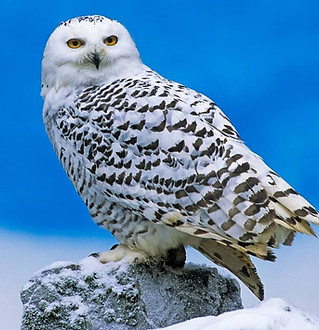
OWLS
About owls of British Columbia
facts
Owls are mostly solitary and nocturnal birds of prey typified by an upright stance, a large, broad head, binocular vision, binaural hearing, sharp talons, and feathers adapted for silent flight.
Owls hunt mostly small mammals, insects, and other birds, although a few species specialize in hunting fish. They are found in all regions of the Earth except Antarctica and some remote islands.
Owls are mostly solitary and nocturnal birds of prey. Their feathers are specially adapted for silent flight.
Cornell University Lab of Ornithology has kindly provided links for greater detail on each bird listed below. Click on the link to get specific information on identification, habitat, sounds & much more.
Small owls
Flammulated Owl
Very small owl with mottled grey and rust markings, small “ear” tufts, short tail, dark brown eyes. Found in open, older forests of Douglas-fir and Ponderosa Pine.
Call a deep, soft ‘boop” or ‘boo-boop” repeated at intervals of 2-3 seconds.
Diet is almost entirely moths, crickets and other insects; nests in old woodpecker holes. Present from early May to September-October; migrates to Mexico in winter.

Western Screech-Owl
Small-medium sized owl; mottled brownish-grey, yellow eyes, “ear” tufts.
Strongly tied to streamside riparian woodlands of cottonwood, birch and aspen. They are nocturnal and non-migratory, with a broad diet that includes rodents, small birds, small fish, large insects, worms, crayfish, scorpions, reptiles, and amphibians. Call is a series of whistled hoots that speed up like a ‘bouncing ball”; also a double trill. Screech owls do not screech (a screeching owl is usually a young Great Horned).

Northern Pygmy Owl
Very small owl with yellow eyes and bill, relatively long tail and large feet, black spots on the nape of the neck that mimic large eyes. Pygmy-owls are active during the day, hunting small rodents, birds, and insects. They are aggressive hunters, occasionally taking prey larger than themselves.
Nest in coniferous forests; some descend into rural and suburban areas in winter. They are non-migratory and nest in tree cavities.
Call is a hollow, whistled kook, repeated once every two seconds, becoming a rapid trill when agitated.
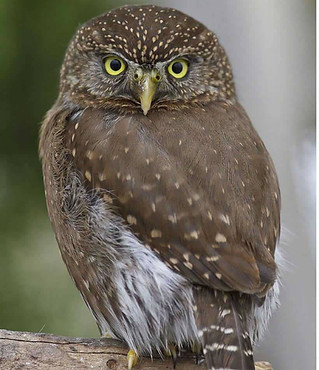
Boreal Owl
Small-medium sized owl with large round, white face framed in black, charcoal cheeks. Young are solid chocolate brown.
Call a deep, soft ‘boop” or ‘boo-boop” repeated at intervals of 2-3 seconds.
Found in subalpine and boreal spruce forests, nests in tree cavities. They are nocturnal that prey primarily on voles, large insects and small birds.
Male’s courtship call is a high-pitched, rapid series of whistled hoots that rises and falls in pitch; other calls include a sharp “skiew” and a nasal “mooo-a”.
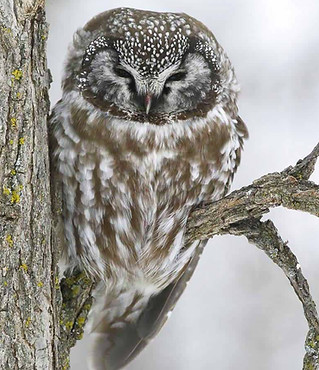
Northern Saw-whet Owl
Small owl with proportionately large head, yellow eyes, and no ear tufts.
Adults have streaked breasts; young have solid brown breast and head.
Found in all forested habitats where cavities are available for nesting. Present year-round, but many birds at northern end of range move south in winter. Highly nocturnal, they hunt deer mice and other small rodents, occasionally birds and large insects.
Courtship call of male a monotonous series of short whistles repeated twice per second. Agitated birds give sharp, rasping calls or cat-like meows.
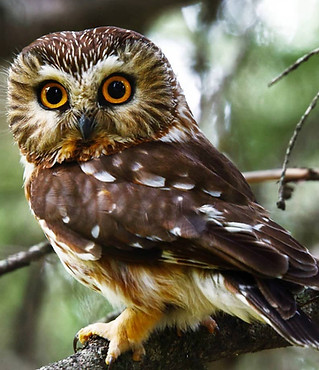
Medium-sized owls
Long-eared Owl
Rather slender owl with long wings, yellow eyes, greyish plumage, rust-coloured facial disc, and long “ear” tufts placed close together near centre of head.
Found in open forests or deciduous groves in grasslands, nesting in stick nests built by crows, magpies or hawks. Highly nocturnal; they hunt over meadows, pastures and other open habitats for meadow voles.
Sometimes gregarious in winter, roosting in small groups in dense trees or shrubs. Males give a low, hollow “oooo” call; females give a variety of nasal barking and wailing calls. Territorial birds will often smack their wings together in flight to produce a loud single clap.

Barn Owl
Generally pale owl with dark brown eyes, heart shaped face, no “ear” tufts, deep rust or buffy colour. Males are paler than females.
Found in a wide variety of habitats that include open areas. They hunt at night for meadow voles over pastures and grasslands, and nest in abandoned buildings, caves, barns, and tree cavities. Barn Owls will breed year-round if food is plentiful. They are non-migratory and cannot survive long in areas with deep winter snow.
Call is a long hissing scream, with screeching, twittering, and squeaking sounds. They do not hoot.

Short-eared Owl
Rather slender owl with yellow eyes framed by dark feather mask, very small “ear” tufts (often not visible), body buff-coloured, streaked with brown.
Found in open habitats including marshes, bogs, tundra and grassland. Nest on the ground in dense grasses or other low vegetation. They are active by day-primarily in the morning and evening-hunting for meadow voles and other small rodents by coursing over open habitats.
Call is a raspy, high barking sound; males give a series of low hoots.
Territorial birds can produce a rapid series of clapping sounds with their wings.

Northern Hawk Owl
Characteristics are long wings and tail (like hawk or falcon), round face framed with black, and a barred chest. Habitat includes old burns in subalpine or boreal forests, and northern mixed woodlands. Nest in tree cavities. Perch in the open on treetops, scanning for prey. Flight is low and swift-falcon-like–and they sometimes hover over prey. They feed primarily on meadow voles, and are somewhat nomadic in their search for areas with high densities of this prey.
Male courtship call is a trilling, melodious whistle; other calls include chirping and screeching.
.jpg)
Burrowing Owl
A long-legged, ground-dwelling owl with yellow eyes, spotted brown plumage, no “ear” tufts. Young have a less spotted brown plumage. Found in a variety of open habitats: savannas, desert and grasslands.
Nests are placed underground, usually in abandoned animal burrows, sometimes in loose colonies. Migratory, flying to California and Mexico in October and returning in late March.
Diet includes insects, rodents, songbirds, and reptiles.
Burrowing Owls are listed as Endangered in Canada and were extirpated from British Columbia in the 1970s. There is an active effort to reintroduce this species into BC using captive breeding and release programs.
Male courtship call is a mellow “coo-coo oo”; another common call is a nasal “kee kikadik”. When the young are alarmed they produce a vibrating hiss much surprisingly similar to the sound of a rattlesnake.
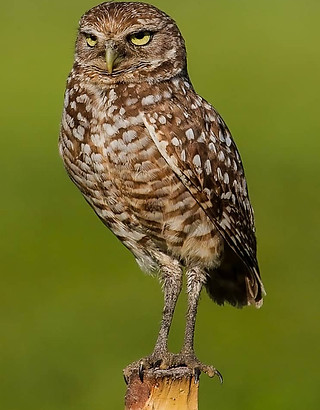
Large owls
Great Grey Owl
Very large, grey owl with yellow eyes set in a very large facial disc, no “ear” tufts, white “bowtie”.
Found in montane and boreal forests, wooded bogs, and mixed or coniferous forests with meadow clearings. Nests in abandoned crow or hawk nests; also commonly on top of large, broken-top snags. Generally non-migratory; hunts both day and night for small rodents, primarily meadow voles and pocket-gophers.
Call is a series of deep resonant WHOOs.
Provincial Bird of Manitoba.

Spotted Owl
Large owl with round, large head, no “ear” tufts, dark brown eyes, yellow bill. Chocolate brown above, breast and belly heavily spotted and barred with brown.
Found in old growth coniferous forests; nests atop large broken-top trees and on mistletoe platforms. Nocturnal and non-migratory, their diet in British Columbia consists mainly of woodrats and flying squirrels; also large insects.
Call is a series of 3 or 4 barks and hoots: Hoo! Hoo-hoo! Hoooo! Female gives a loud rising whistle as a contact call.
Threatened by habitat loss through logging; the Spotted Owl is listed as Endangered in Canada and only a handful of adults remain in the wild. A captive breeding program is underway to save this species in British Columbia.

Great Horned Owl
Large owl with distinct “horns”, deep yellow eyes, white bib under chin, body mottled grey and brown. This is the most widespread owl in Canada, found in almost every habitat except tundra. They nest in stick nests built by hawks, crows, ravens or other large birds, also cliff ledges. Great Horned Owls hunt medium-sized prey such as rats, rabbits, hares, skunks, grouse, but will also take mice and a wide variety of other prey. Call is a rhythmic ‘Hoo-Hoohoo-Hoo-Hoo’; young birds give loud, rising screeches.
Provincial Bird of Alberta.

Barred Owl
Large grey-brown owl with round head, dark eyes, yellow bill; belly white with strong brown vertical streaks.
Call a deep, soft ‘boop” or ‘boo-boop” repeated at intervals of 2-3 seconds.
Found in dense coniferous forests, nesting in large tree cavities, mistletoe platforms, and old hawk nests. They hunt a wide variety of prey, from mice to squirrels and grouse.
Calls are rhythmic hoots in series of eight notes that sound like “who cooks for you—who cooks for you-allll”. Also a drawn out “hoo-ah”, various barking calls and shrieking whistles.
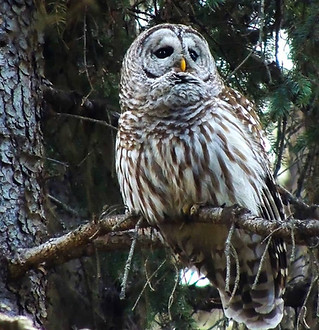
Snowy Owl
Very large (the heaviest owl in North America) white owl with deep yellow eyes, black beak, smooth head, no “ear” tufts. Females and immature birds have more grey flecking than adult males, which can be pure white.
Breed on arctic tundra, in winter found primarily along coastlines or open grasslands, grain farms. Diet on the breeding grounds consists of lemmings, ptarmigan and other available prey; in the winter they eat a wide variety of prey, but primarily ducks, grebes, and larger rodents. Generally remain at high latitudes throughout the year, but some (primarily young birds) move south in winter when prey availability is low in the Arctic.
Snowy Owls are silent in winter; on the breeding grounds they give for deep hoots and harsh barking calls.
The Provincial Bird of Quebec.
